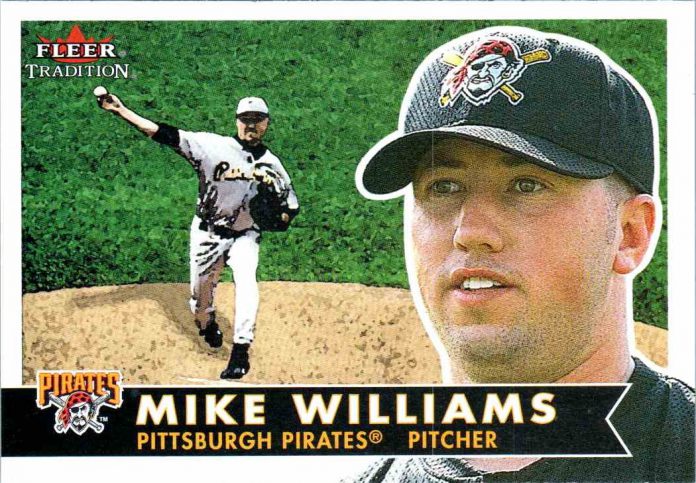Two former Pittsburgh Pirates players born on this date and one trade of note.
The Trade
On this date in 2003, the Pirates traded closer Mike Williams to the Philadelphia Phillies for minor league pitcher Frank Brooks. Williams was in his second tour with the Pirates as their closer. He had originally been with the Pirates from 1998 until the 2001 trading deadline, when they sent him to the Houston Astros for pitcher Tony McKnight. He re-signed with the Pirates after the season and had an All-Star year in 2002, saving 46 games, which was a team record until topped by Mark Melancon in 2015. In 2003, Williams made the All-Star team again, although he was chosen solely because every team needed a representative. At that point, he had a 1-3, 6.27 record in 40 games, with 25 saves at the time of the trade. Brooks was a 24-year-old lefty reliever, who was taken in the 13th round of the 1999 amateur draft by the Phillies. At the time of the deal, he had a 2.30 ERA in 34 appearances, with 71 strikeouts in 58.2 innings, while playing at Double-A .
After the deal, Williams continued to struggle for the Phillies, going 0-4, 5.96 in 28 games with three saves. He was let go via free agency after the season and never played in the majors again, ending his career with his only two All-Star appearances coming in his last two seasons. Brooks went to Double-A for one game, then went to Triple-A, where he had a 2.54 ERA in 16 outings. He was taken in the 2003 Rule 5 draft, but eventually came back to the Pirates after changing hands three times. He went to Triple-A until late August in 2004, when the Pirates called him up for his Major League debut. Brooks pitched 11 games with Pittsburgh, going 0-1, 4.67 in 17.1 innings. He was taken off waivers by the Dodgers after the season completed and he ended up pitching just one more game in the big leagues, walking the only batter he faced in that contest.
The Players
Dick Smith, infielder for the Pirates from 1951 until 1955. The Pirates signed him in 1949 as an amateur free agent out of Lock Haven University in Pennsylvania, one of just three players from that school to make the majors. Smith moved quickly through the minors due to his bat, hitting .315 in 1949, then .321 the next year, followed by a .330 average in 1951 while playing for Charleston of the South Atlantic League. He was a September call-up that season, batting .174 in 12 games. He made the Pirates Opening Day roster in 1952, although he was seldom used and ended up back in the minors by mid-June, getting recalled in September.
Smith must’ve felt déjà vu the next two years, as he was a September recall in 1953, then made the Opening Day roster again in 1954, only to be sent down after a short time. He had his fifth and final stint with the 1955 Pirates, making his third Opening Day roster, but this time Smith was barely given a chance to playing, walking in his only plate appearance, while appearing another three times as a pinch-runner. In his five seasons, he hit .134 with 11 RBIs in 70 games. That .174 average during his first chance in 1951, would be his highest average in a season with the Pirates. Smith played 37 games at third, 18 at shortstop and four at second base, starting a total of 47 games in the majors. He played in the minors until 1960 without a return trip to the big leagues.
Irv Young, pitcher for the 1908 Pirates. He was a very good pitcher for a very bad Boston Beaneaters/Doves team from 1905 until the time the Pirates traded for him. Young led the NL in innings pitched as a rookie, then repeated the feat in 1906, throwing a combined total of 736.1 innings. Pittsburgh had tried to purchase him after his rookie season and they were willing to pay a high price, but Boston would not sell their star hurler. It was unfortunate for Young, who finished his time in Boston with a 50-78 record, despite a solid 3.15 ERA and 15 shutouts.
The Pirates acquired Young on June 18, 1908 in exchange for two rookie pitchers named Tom McCarthy and Harley Young. A popular trend at the time was giving a nickname to a player just because they had the same last name as a previous player. Sometimes it worked out bad for that player, as in the case with both Irv Young and Harley Young. They gained the nicknames, “Cy the Second” for Irv and “Cy the Third” for Harley, although neither were anywhere near the great Cy Young as far as talent or career accomplishments. Irv pitched well for the 1908 Pirates, going 4-3, 2.01 in seven starts and nine relief outings. Prior to the 1909 season, he was sold to a minor league team and spent the entire season down on the farm. He pitched two more years in the majors for the Chicago White Sox (1910-11) before finishing his career with another five seasons in the minors.


